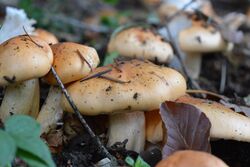Biology:Hygrophorus pudorinus
| Hygrophorus pudorinus | |
|---|---|

| |
| Scientific classification | |
| Domain: | Eukaryota |
| Kingdom: | Fungi |
| Division: | Basidiomycota |
| Class: | Agaricomycetes |
| Order: | Agaricales |
| Family: | Hygrophoraceae |
| Genus: | Hygrophorus |
| Species: | H. pudorinus
|
| Binomial name | |
| Hygrophorus pudorinus (Fr.) Fr. (1836)
| |
| Synonyms | |
| |
Hygrophorus pudorinus, commonly known as the blushing waxycap,[1] turpentine waxycap,[2] or spruce waxy cap,[3] is a species of fungus in the genus Hygrophorus.[4]
Swedish mycologist Elias Magnus Fries described it as Agaricus pudorinus in his 1821 work Systema Mycologicum.[5] It became Hygrophorus pudorinus with the raising of Hygrophorus to genus rank. The species name is the Latin word pudorinus "blushing".[6]
The species is classified in the subsection Pudorini of genus Hygrophorus, along with the closely related species H. erubescens and H. purpurascens.[7]
The fruit body (mushroom) is a fair size, with a 5–12 cm (2–4 3⁄4 in) diameter pink to golden convex cap with a downrolled margin that is lighter in colour. The cap surface is sticky. The pink to yellow-white gills are decurrent. The thick stipe is 4–16 cm (1 5⁄8–6 1⁄4 in) tall and 1–3 cm (3⁄8–1 1⁄8 in) wide.[8] The spore print is white and the oval spores measure 7–10 × 5–6 micrometres. The thick flesh is pale pink or orange to white. The mushroom does not bruise red and has no distinctive odour, though it can taste like turpentine.[1]
Hygrophorus pudorinus is found in coniferous woodlands under fir and spruce trees[9] across western and northeastern North America;[1] it is particularly common in Canada[9] and the Rocky Mountains.[6] The mushrooms appear in groups or fairy rings in late summer and autumn.[1] They often grow in boggy places in sphagnum moss.[2]
Despite its taste, it is edible after cooking.[9] Its variable appearance makes identification difficult and hence raises risk of misidentification.[1]
References
| Hygrophorus pudorinus | |
|---|---|
| Mycological characteristics | |
| gills on hymenium | |
| cap is convex | |
| hymenium is adnate or decurrent | |
| stipe is bare | |
| spore print is white | |
| edibility: edible | |
- ↑ 1.0 1.1 1.2 1.3 1.4 A Field Guide to Mushrooms: North America. Houghton Mifflin Harcourt. 1998. pp. 209. ISBN 9780395910900. https://books.google.com/books?id=kSdA3V7Z9WcC&pg=PA209.
- ↑ 2.0 2.1 Mushrooms of Northeastern North America. Syracuse University Press. 1997. pp. 143. ISBN 978-0-8156-0388-7. https://books.google.com/books?id=T2uU12XcRD4C&pg=PA143.
- ↑ Arora, David (1986). Mushrooms demystified: a comprehensive guide to the fleshy fungi (Second ed.). Berkeley: Ten Speed Press. ISBN 978-0-89815-169-5.
- ↑ "Hygrophorus pudorinus (Fr.) Fr.". MycoBank. International Mycological Association. http://www.mycobank.org/BioloMICS.aspx?Table=Mycobank&Rec=166309&Fields=All.
- ↑ Fries EM. (1821) (in la). Systema Mycologicum. 1. Lund: Ex Officina Berlingiana. p. 33. https://www.biodiversitylibrary.org/page/4338000.
- ↑ 6.0 6.1 Evenson VS. (1997). Mushrooms of Colorado and the Southern Rocky Mountains. Westcliffe Publishers. p. 68. ISBN 978-1-56579-192-3. https://books.google.com/books?id=EAeDeyqZLq0C&q=Hydnellum%20peckii&pg=PA68.
- ↑ Lodge DJ (2014). "Molecular phylogeny, morphology, pigment chemistry and ecology in Hygrophoraceae (Agaricales)". Fungal Diversity 64 (1): 1–99 (see p. 64). doi:10.1007/s13225-013-0259-0. https://iris.unito.it/bitstream/2318/136089/1/1205754_Molecular%20phylogeny.pdf.

- ↑ Davis, R. Michael; Sommer, Robert; Menge, John A. (2012). Field Guide to Mushrooms of Western North America. Berkeley: University of California Press. pp. 130. ISBN 978-0-520-95360-4. OCLC 797915861. https://www.worldcat.org/oclc/797915861.
- ↑ 9.0 9.1 9.2 States J (1990). Mushrooms and Truffles of the Southwest. University of Arizona Press. pp. 66. ISBN 9780816511921. https://books.google.com/books?id=WIsWN-wpnb0C&pg=PA66.
Wikidata ☰ Q1323772 entry
 |

